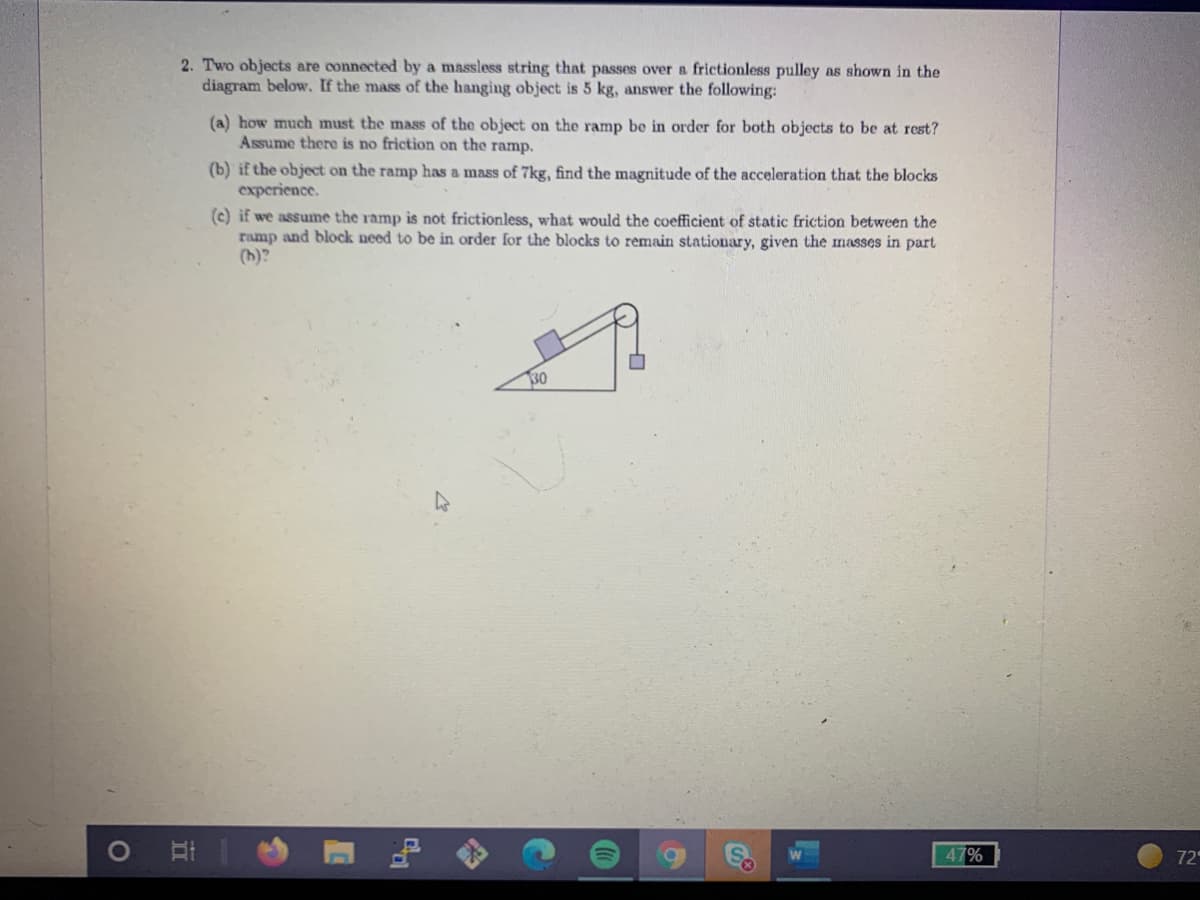2. Two objects are connected by a massless string that passes over a frictionless pulley as shown in the diagram below. If the mass of the hanging object is 5 kg, answer the following: (a) how much must the mass of the object on the ramp be in order for both objects to be at rest? Assume there is no friction on the ramp. (b) if the object on the ramp has a mass of 7kg, find the magnitude of the acceleration that the blocks experience. (c) if we assume the ramp is not frictionless, what would the coefficient of static friction between the ramp and block need to be in order for the blocks to remain stationary, given the masses in part (h)? 30
2. Two objects are connected by a massless string that passes over a frictionless pulley as shown in the diagram below. If the mass of the hanging object is 5 kg, answer the following: (a) how much must the mass of the object on the ramp be in order for both objects to be at rest? Assume there is no friction on the ramp. (b) if the object on the ramp has a mass of 7kg, find the magnitude of the acceleration that the blocks experience. (c) if we assume the ramp is not frictionless, what would the coefficient of static friction between the ramp and block need to be in order for the blocks to remain stationary, given the masses in part (h)? 30
College Physics
1st Edition
ISBN:9781938168000
Author:Paul Peter Urone, Roger Hinrichs
Publisher:Paul Peter Urone, Roger Hinrichs
Chapter5: Further Applications Of Newton's Laws: Friction, Drag, And Elasticity
Section: Chapter Questions
Problem 9PE: Show that the acceleration of any object down an incline where friction behaves simply (that is,...
Related questions
Question

Transcribed Image Text:2. Two objects are connected by a massless string that passes over a frictionless pulley as shown in the
diagram below. If the mass of the hanging object is 5 kg, answer the following:
(a) how much must the mass of the object on the ramp be in order for both objects to be at rest?
Assume there is no friction on the ramp.
(b) if the object on the ramp has a mass of 7kg, find the magnitude of the acceleration that the blocks
experience.
(c) if we assume the ramp is not frictionless, what would the coefficient of static friction between the
ramp and block need to be in order for the blocks to remain stationary, given the masses in part
(h)?
30
47%
72
Expert Solution
This question has been solved!
Explore an expertly crafted, step-by-step solution for a thorough understanding of key concepts.
This is a popular solution!
Trending now
This is a popular solution!
Step by step
Solved in 3 steps with 2 images

Recommended textbooks for you

College Physics
Physics
ISBN:
9781938168000
Author:
Paul Peter Urone, Roger Hinrichs
Publisher:
OpenStax College

Principles of Physics: A Calculus-Based Text
Physics
ISBN:
9781133104261
Author:
Raymond A. Serway, John W. Jewett
Publisher:
Cengage Learning

Physics for Scientists and Engineers
Physics
ISBN:
9781337553278
Author:
Raymond A. Serway, John W. Jewett
Publisher:
Cengage Learning

College Physics
Physics
ISBN:
9781938168000
Author:
Paul Peter Urone, Roger Hinrichs
Publisher:
OpenStax College

Principles of Physics: A Calculus-Based Text
Physics
ISBN:
9781133104261
Author:
Raymond A. Serway, John W. Jewett
Publisher:
Cengage Learning

Physics for Scientists and Engineers
Physics
ISBN:
9781337553278
Author:
Raymond A. Serway, John W. Jewett
Publisher:
Cengage Learning

Physics for Scientists and Engineers with Modern …
Physics
ISBN:
9781337553292
Author:
Raymond A. Serway, John W. Jewett
Publisher:
Cengage Learning

College Physics
Physics
ISBN:
9781285737027
Author:
Raymond A. Serway, Chris Vuille
Publisher:
Cengage Learning

College Physics
Physics
ISBN:
9781305952300
Author:
Raymond A. Serway, Chris Vuille
Publisher:
Cengage Learning